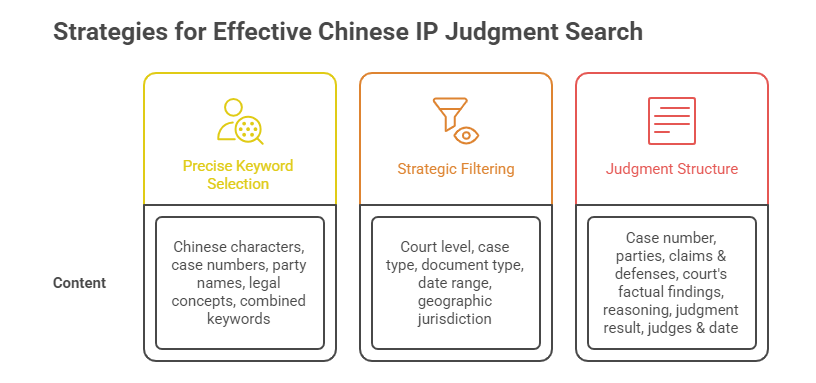Understanding the intellectual property (IP) litigation history of Chinese companies or individuals is crucial for informed business decisions, risk mitigation, and competitive intelligence. The official portal for accessing this vital information is China Judgments Online (中国裁判文书网), maintained by China’s Supreme People’s Court. While seemingly straightforward, mastering its advanced features is essential for foreign researchers navigating language barriers and complex search logic. This guide provides practical strategies for effective IP judgment searches.

Mastering the Search Interface (Beyond Basics)
- Precise Keyword Selection (Mandarin is Key):
- Use Chinese Characters: The database primarily indexes content in Chinese. Relying solely on English translations yields poor results. Identify and use the precise Chinese terms for your search.
- Leverage Case Numbers: If you have a specific case number (e.g., (2023)最高法知民终XX号), entering it directly is the most accurate method. Case numbers follow a structured format indicating court level, year, case type division, and sequence number.
- Utilize Party Names: Search using the exact Chinese name of the plaintiff (原告), defendant (被告), or the involved company/individual. Ensure accuracy, including correct characters.
- Target Legal Concepts: Use specific legal terms like “商标侵权” (trademark infringement), “专利侵权” (patent infringement), “著作权侵权” (copyright infringement), “不正当竞争” (unfair competition), or “商业秘密” (trade secrets).
- Combine Keywords: Use the advanced search options to combine criteria (Party Name + Cause of Action + Court Level + Date Range) for highly targeted results.
- Strategic Filtering for Relevance:
- Court Level: Filter judgments by the court level (e.g., Supreme People’s Court, Higher People’s Courts, Intermediate People’s Courts, Primary People’s Courts). Higher-level courts often handle more complex or precedent-setting IP cases.
- Case Type: Crucially, select “知识产权纠纷” (Intellectual Property Disputes) or its sub-categories (Patent, Trademark, Copyright, Technology Contracts, Unfair Competition) under the “案由” (Cause of Action) filter.
- Document Type: Specify “判决书” (Judgments) or “裁定书” (Rulings) depending on your need. Judgments contain the full reasoning and outcome.
- Date Range: Narrow searches to specific years or periods relevant to your investigation. Judgments are typically published within a few months of becoming effective.
- Geographic Jurisdiction: Filter by province or specific city courts if location is relevant to the parties or dispute.
- Deciphering the Judgment Structure
Understanding the standard sections of a Chinese IP judgment is vital for extracting key information efficiently:- Case Number: Unique identifier for the judgment.
- Parties: Clearly lists the plaintiff(s), defendant(s), and any third parties with their details.
- Claims & Defenses (原告诉称 / 被告辩称): Summarizes the arguments presented by both sides.
- Court’s Factual Findings (法院查明): Details the evidence reviewed and the facts established by the court.
- Reasoning (法院认为): The core section. The court applies relevant laws (citing specific articles from laws like the Trademark Law, Patent Law, Copyright Law, Anti-Unfair Competition Law) to the established facts, explaining its legal analysis.
- Judgment Result (判决结果): The final ruling – who wins, what remedies are ordered (injunction, damages, destruction of infringing goods, public apology, etc.), and liability for court costs.
- Judges & Date: Lists the judicial panel and the date the judgment was issued.
Overcoming Common Challenges & Limitations
- Translation Needs: Deep analysis requires translating judgments. While basic browser translation tools offer a gist, professional legal translation is recommended for accuracy in complex cases, especially concerning nuanced legal reasoning and technical details in patent disputes. Understanding the reasoning is key to assessing precedent value.
- Incomplete Publication: Not all judgments are published. Exclusions often include cases involving state secrets, personal privacy (unless consented), juvenile delinquency, or where parties have specifically requested non-publication (subject to court approval). Be aware that your search might not uncover every relevant case.
- Interpretation Nuance: Chinese IP law evolves rapidly. Court interpretations of statutes and precedents can be nuanced. Consulting with legal professionals specializing in Chinese IP law is often necessary to fully grasp the implications of a judgment’s reasoning for future cases or business strategies. The court’s analysis of factors like “confusing similarity” in trademarks or “equivalence” in patents is critical.
- Authenticating Documents: For official or legal purposes overseas (e.g., litigation, due diligence), judgments downloaded directly from the website usually require authentication. This involves obtaining an official stamped copy from the issuing court and then undergoing either the Apostille process (for Hague Convention member countries) or Consular Legalization (for non-member countries) to verify the document’s origin for use abroad. This step is crucial for the document’s legal validity outside China. Our Company Documents Retrieval & Authentication Service can assist in navigating this complex process efficiently.
- Complexity & Time Commitment: Conducting thorough, multi-layered searches and analyzing the results requires significant time, familiarity with the Chinese legal system, and language skills. For comprehensive due diligence or strategic analysis, engaging professional services specializing in Chinese legal research and IP intelligence is often the most efficient and reliable approach. Consider our specialized Intellectual Property Search Service for in-depth analysis tailored to your specific risk assessment needs.
Conclusion
China Judgments Online is an indispensable, authoritative resource for researching IP litigation in China. Moving beyond basic keyword searches by mastering advanced filters (court level, specific IP case types, dates), understanding the structure of judgments, and strategically using Chinese legal terminology significantly enhances the effectiveness of your research. However, researchers must remain cognizant of the platform’s limitations regarding publication completeness and the challenges of translation, legal interpretation, and document authentication for international use. Navigating these complexities often necessitates leveraging professional translation and authentication services, or partnering with specialized research providers to gain accurate and actionable insights into the Chinese IP litigation landscape. Mastering these advanced techniques empowers businesses and legal professionals to make more informed decisions based on concrete legal precedents.
